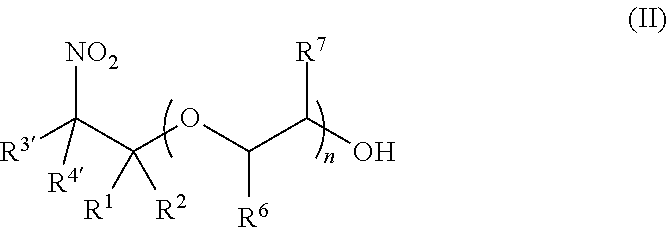Synthesis of (2-nitro)alkyl (meth)acrylates via transesterification of (meth)acrylate esters
a technology of alkyl alkyl (meth)acrylate and esters, which is applied in the direction of carboxylic acid ester formation/introduction, chemistry apparatus and processes, organic chemistry, etc., can solve the problems of affecting the application of the product, affecting the scale of synthesis of these materials, and creating unwanted waste streams
- Summary
- Abstract
- Description
- Claims
- Application Information
AI Technical Summary
Benefits of technology
Problems solved by technology
Method used
Image
Examples
example 1
Synthesis of 2-Nitro-2-Methylpropyl Methacrylate
[0049]
[0050]Procedure I: To a 1000 ml 4 necked flask fitted with a stirrer, thermometer, 10-tray distillation head and a reflux splitter was added 2-nitro-2 methyl propanol (123.5 g, 1.04 mol) and toluene (350 ml). The resulting mixture was heated to 100° C. under reduced pressure (400 mmHg) and approximately 30 ml of distillate was collected in the receiver in order to dry the contents of the flask via an azeotrope formed between water and the solvent. Then heating turned off and the pot solution was allowed to cool 50-60° C. To the solution were added phenothiazine (115 mg), methyl methacrylate, MMA, (119 g, 1.2 mol) and zirconium acetyl acetonate (7.25 g, 0.015 mol). The reaction mixture was heated to 120° C. under reduced pressure (700 mmHg). Reflux / distillation splitter was set at 20 / 5 and the distillate was collected when the vapor temperature was between 65-70° C. over a 4.5 hour period, weighed accurately and analyzed by quanti...
example 2
Synthesis of 2-Methyl-2-Nitropropane-1,3-Diyl Bis(2-Methylacrylate) (Prophetic)
[0053]
[0054]2-Methyl-2-nitropropane-1,3-diyl bis(2-methylacrylate) may be prepared using essentially the same procedures as described in Example 1 except for substituting 2-methyl-2-nitropropane-1,3-diol as the starting nitroalcohol compound, doubling the number of equivalents of methyl methacrylate, and making other non-critical modifications as needed.
example 3
Synthesis of 2-(Methacryloyloxy)methyl)-2-Nitropropane-1,3-Diyl Bis(2-Methylacrylate) (Prophetic)
[0055]
[0056]2-(Methacryloyloxy)methyl)-2-nitropropane-1,3-diyl bis(2-methylacrylate) may be prepared using essentially the same procedures as described in Example 1 except for substituting 2-(hydroxymethyl)-2-nitropropane-1,3-diol as the starting nitroalcohol compound, tripling the number of equivalents of methyl methacrylate, and making other non-critical modifications as needed.
PUM
| Property | Measurement | Unit |
|---|---|---|
| pressure | aaaaa | aaaaa |
| temperature | aaaaa | aaaaa |
| temperatures | aaaaa | aaaaa |
Abstract
Description
Claims
Application Information
 Login to View More
Login to View More - R&D
- Intellectual Property
- Life Sciences
- Materials
- Tech Scout
- Unparalleled Data Quality
- Higher Quality Content
- 60% Fewer Hallucinations
Browse by: Latest US Patents, China's latest patents, Technical Efficacy Thesaurus, Application Domain, Technology Topic, Popular Technical Reports.
© 2025 PatSnap. All rights reserved.Legal|Privacy policy|Modern Slavery Act Transparency Statement|Sitemap|About US| Contact US: help@patsnap.com



